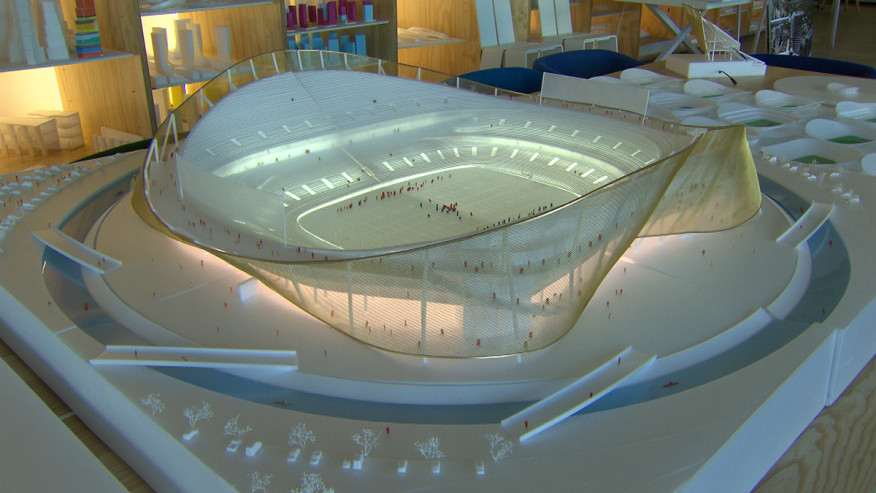It may not end up looking quite so futuristic and a potential site has not been identified, but a preliminary design from starchitect Bjarke Ingels for the NFL’s Washington Redskins was unveiled this weekend — including a prominent spot in CBS’s 60 Minutes.
Ingels is a high-profile star architect with plenty of cutting-edge projects around the world, but his choice by Redskins owner Dan Snyder breaks all the rules when it comes to sport-architecture design. Historically, bringing in the superstar architect to the sports world hasn’t yielded any classics: Robert A. M. Stern didn’t necessarily add a lot to the 1998 renovations to Angel Stadium, Frank Gehry failed to make an impact on the final design for Barclays Center, and we all know what happened when Zaha Hadid submitted plans for the 2020 Tokyo Olympic Stadium. (It did not end well.)
But this could be different. Ingels managed to submit an appropriate futuristic design for a new Redskins stadium, a curvilenear design that looks like it would fit perfectly at the RFK Stadium site in D.C., a site that would work for tailgating while preserving the feel of the first mixed-use stadium in professional sports. The paraboloid-shaped stadium is surrounded by a sea of parking and a moat for kayakers, but don’t take it too seriously: it is pure concept, lacking practical items like light stanchions. As Ingels says:
“When I started studying architecture people would say, you know, ‘Can you tell me why all modern buildings are so boring?’…People had this idea that in the good old days architecture had…ornament and little towers and spires and gargoyles and today, it just becomes very practical,” said Ingels, in a statement released by the show.
“The stadium is designed as much for the tailgating, like the pre-game, as for the game itself,” Ingels said on the show. “Tailgating literally becomes a picnic in a park. It can actually make the stadium a more lively destination throughout the year without ruining the turf for the football game.”…
Ingels said in an email to The Washington Post in January that he was “proud to be part of imagining and designing the framework for the future of American Football.”
“Does the typical NFL stadium have room for improvement?” wrote Ingels. “Yes most certainly. Is it waste of resources to have giant facilities that are only active 10 times a year. Obviously. Therefore we have worked with our team to imagine a facility that can be active both inside and outside all year and all week — not just on a game day. Also we have sought to distill the stadium experience — before, during and after the game — to its essential ingredients — to provide the greatest intimacy for the players and fans, and in doing so to create a more compact and efficient stadium as opposed to the colossal facilities of the past.”
Now, none of this commits the Redskins to a D.C. location, and Virginia Gov. Terry McAuliffe has pitched the team on locations in Loudoun County along the unbuilt second leg of Metro’s Silver Line. But bringing the Redskins — or whatever the team will be called in the future — back to the District of Columbia at the site of the team’s greatest victories would be a huge coup for a team owner whose tenure as Redskins owner has been less than distinguished.
RELATED STORIES: Architect retained for new Redskins stadium: report

